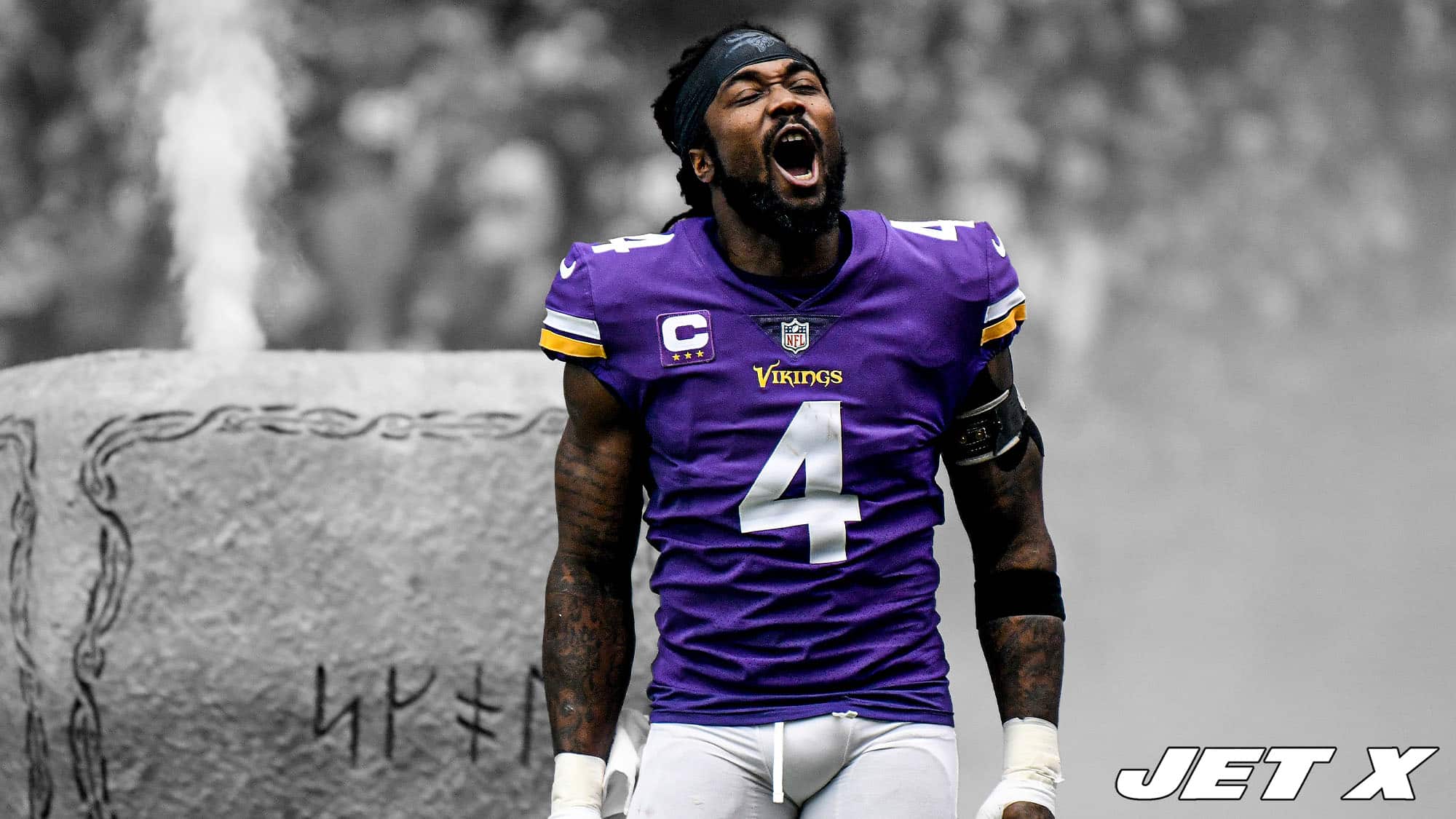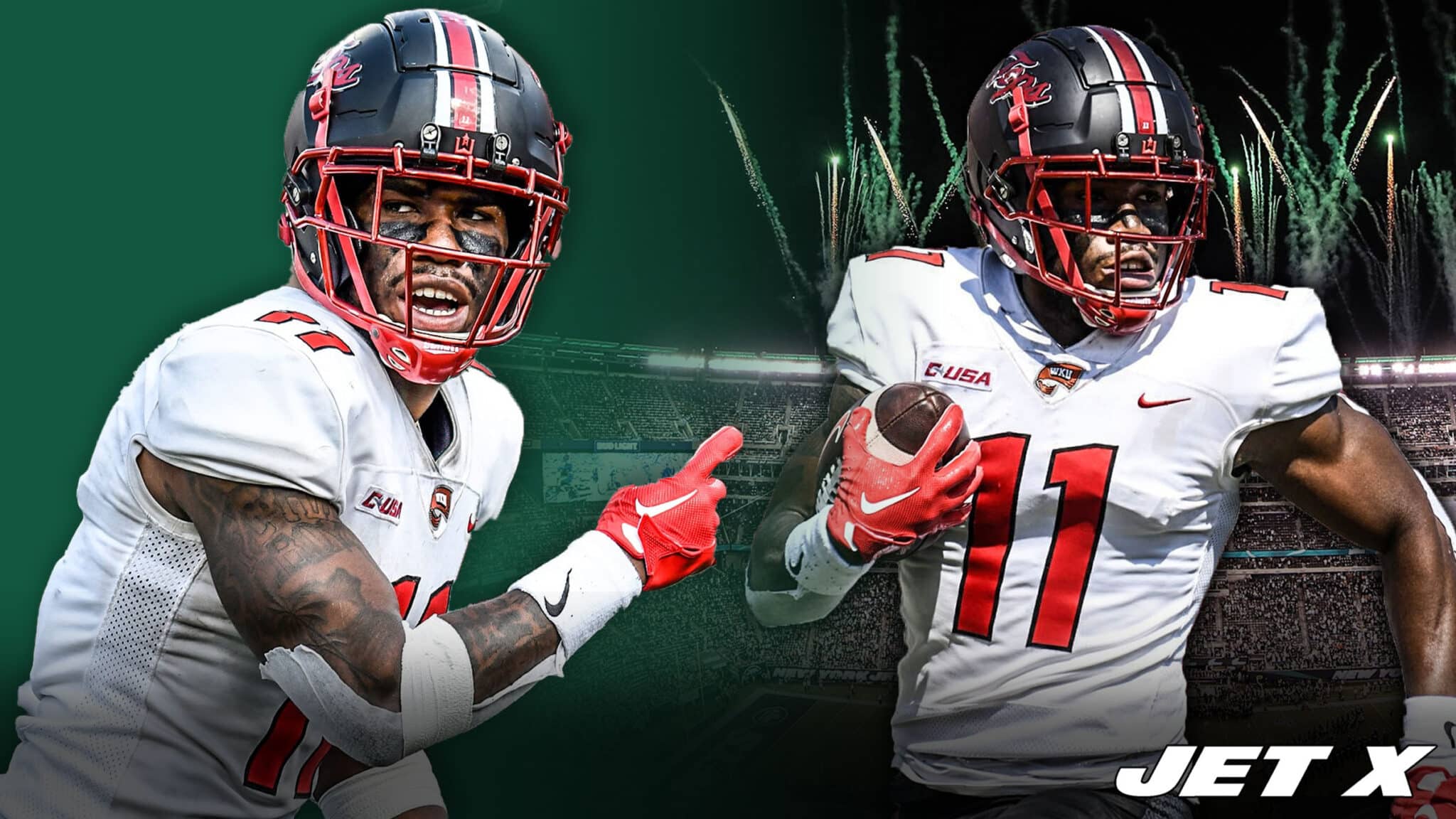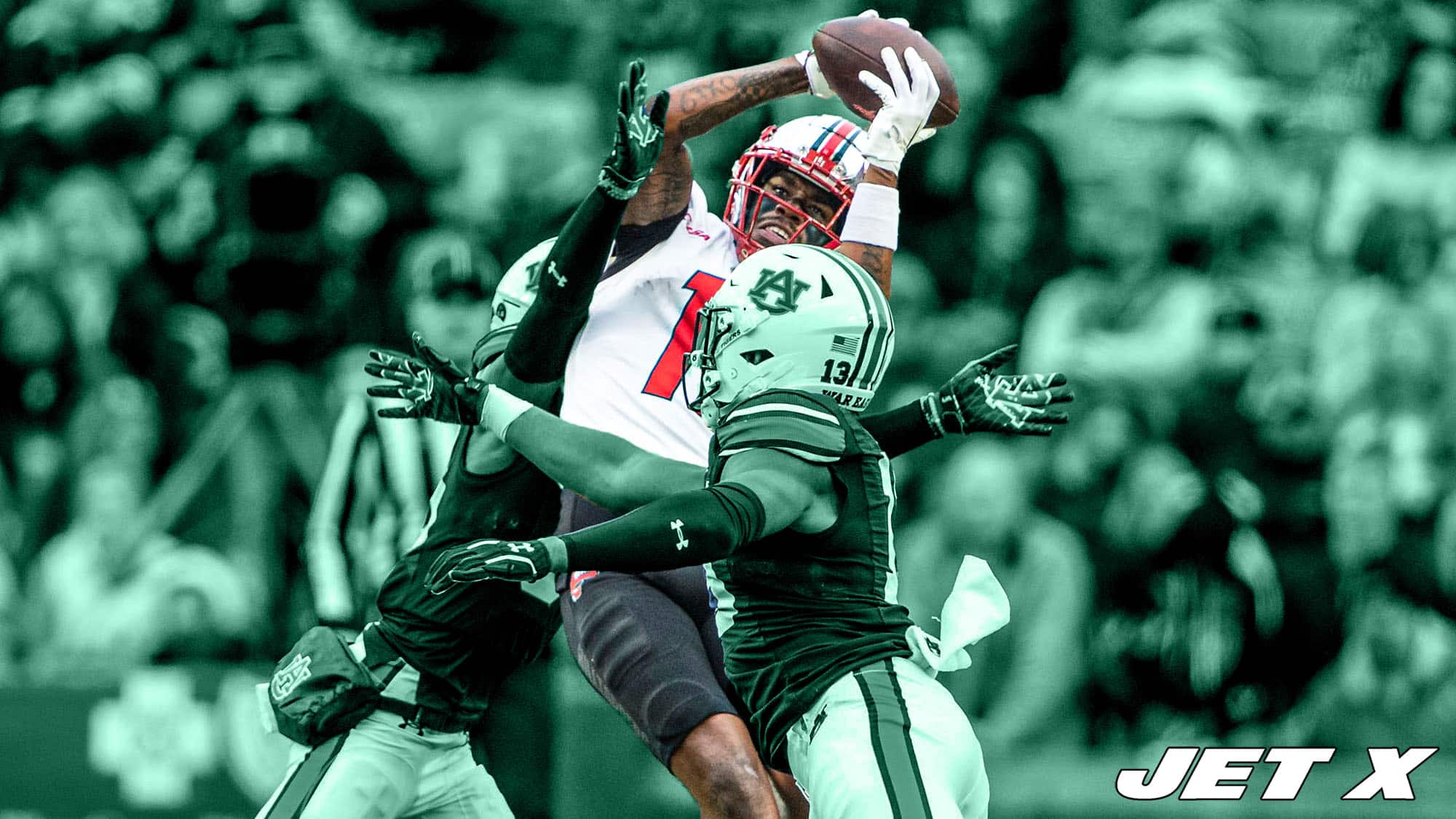Examining the entire package Dalvin Cook would bring to the New York Jets
According to the man himself, the odds are “pretty high” that Dalvin Cook joins the New York Jets.
With Cook closing in on a deal with New York, it’s time to use a combination of film and analytics to evaluate what Cook would bring to the Jets’ offense – both good and bad. What caliber of RB is Cook at this stage of his career? Does he make the Jets a better team?
Let’s find out.
Still has elite long speed and breakaway ability
Despite being in his sixth season and coming off various injuries throughout his career, Cook’s long speed was still his best trait in 2022. He maintains the ability to separate from would-be tacklers when he gets to the second and third levels of the defense.
Cook had 12 “breakaway” runs in 2022, which are considered runs for 15+ yards. On those 12 runs, he gained 344 yards, giving him an average of 28.7 yards per breakaway run. That was the highest average among the 18 running backs with at least 10 breakaway runs.
There were only 21 rushing touchdowns of 50+ yards in the 2022 NFL season. Cook had two of them. Kenneth Walker and Tony Pollard were the only other running backs with two.
In terms of pure straight-line speed, Cook is yet to show any signs of decline. According to NFL Next Gen Stats, Cook reached a top speed of 21.68 miles per hour on the 81-yard touchdown seen below, which was the third-fastest top speed reached by a RB on a rush attempt in the 2022 season (Breece Hall ranked second at 21.87 while Walker was first at 22.09).
Cook hit 20.25 miles per hour on this 53-yard score against Miami.
In both of the plays above, Cook shows off his elite acceleration. When he gets a window to stick his foot in the ground and explode vertically toward the end zone, he reaches his top speed in a hurry. Combine the elite acceleration with the elite top speed, and you get the man who led running backs in yards per breakaway run. Give Cook a big hole and he can maximize it as well as anyone.
Outside of Breece Hall, the Jets didn’t have a running back who could hit home runs last season. Hall’s knack for swiftly ending drives with long touchdowns was a valuable asset for an offense that struggled to move the ball on a play-to-play basis or score in the red zone. Cook brings the same skill. His ability to occasionally tilt the tide of a game with a massive run is the best trait he offers at this stage of his career.
But, as we’ll see, there are other aspects of his running game that have fallen off since his peak years.
Extreme propensity for stuffed runs (causing overall poor performance as a rusher)
Breakaway runs were just about the only positive aspect of Cook’s performance as a rusher in 2022. Outside of the flashy plays that pop up in his highlight reel, he mostly struggled, which caused him to record poor overall rushing statistics despite the big-play success.
Cook ranked near the bottom in advanced rushing metrics. Out of the 43 running backs with at least 100 carries, he ranked 39th in EPA per rush (-0.20), 41st in rush yards over expectation (RYOE) per rush (-0.1), and 35th in DVOA (-10.8%).
While Cook’s standard yards-per-carry average of 4.44 seems pretty good on the surface, Cook’s poor ratings in EPA (Expected Points Added) and DVOA (Defense-Adjusted Value Over Average) prove his YPC is misleading. They show Cook was actually producing inefficient results when accounting for variables such as down, distance, and game situation – and in DVOA’s case, opponent quality.
This is also a great example of how the YPC stat is biased toward big-play backs like Cook. According to YPC, if a player has a game with one 80-yard run and 14 zero-yard runs, it’s a great performance – that’s 80 yards on 15 carries for an excellent average of 5.3 yards per carry. Stats like EPA and DVOA do not fall into the same trap. They tone down the value of long runs to an accurate level, meaning they properly emphasize play-to-play consistency while YPC does not.
Meanwhile, Cook’s poor rating in RYOE shows that he frequently gained fewer yards than he was expected to based on the blocking presented to him.
So, what caused Cook to rank poorly in all of these metrics despite his apparently solid numbers in the box score? It’s simple: His extreme propensity for getting stuffed.
Of Cook’s 264 carries, 62 of them resulted in no gain or a loss. That’s a stuff rate of 23.5%, which ranked third-worst among running backs with at least 100 carries.
If you remove Cook’s 12 breakaway runs for 344 yards, Cook had 252 carries for 829 yards – just 3.29 yards per carry. Out of the 33 running backs with at least 150 total carries, Cook ranked 24th in YPC on non-breakaway runs.
Essentially, this shows that if Cook did not break loose for an enormous gain, he usually gained little to nothing. Cook failed to get enough of those healthy 4-10 yard chunks that are crucial to keep an offense moving. He was extremely boom-or-bust – and since the “boom” was only 12 out of his 264 carries, the “bust” was what you saw for the majority of the time, leading to his poor rankings in stats like EPA and DVOA.
The question is, does Cook deserve blame for his high rate of stuffs? Or was it the offensive line’s fault?
Statistically speaking, most signs point toward Cook. Minnesota’s offensive line rankings are all over the place, but none of them claim the unit was bad enough to where Cook should have been getting stuffed at the third-worst rate. The Vikings ranked third-best in PFF’s run-blocking grade and 18th in ESPN’s run-block win rate. Even if you lean toward ESPN’s ranking as more accurate than PFF’s, a No. 18 ranking is still far off from Cook’s third-worst placement in stuff rate.
Looking at the film, there are many examples of Cook running into stuffs that could have been avoided.
Cook displays shoddy vision on this play as he cuts away from a hole that is opening up in the B-gap and straight into the arms of a waiting defender on the inside.
Here is another example of questionable vision leading to a stuff. It’s second-and-2, so Cook doesn’t need much for this run to be successful. He is given an enormous hole in the A-gap, and while a linebacker is waiting there, he’s far enough off the ball for Cook to easily plow into the hole, put his head down, and truck through the linebacker to get what he needs for the first down. Instead, Cook hesitates, turns inside toward the traffic, and gets stuffed for no gain.
Cook again denies a wide-open A-gap because he sees the linebacker at the second level, and instead goes inside where there is even more traffic, leading to a no-gainer on first down. Despite the linebacker’s presence, there is plenty of vertical space, and Cook also has his center coming off the combo block to pick up the linebacker.
On each of the plays above, you would like to see Cook take the open hole and get a nice chunk of 4-5 yards to keep Minnesota ahead of the chains. But you can see Cook plays with a big-play-seeking mentality causes him to bounce around and turn should-be positive plays into stuffs that put the offense in unfavorable down-and-distance situations.
Poor blocker
Protecting Aaron Rodgers will be vital for the Jets this season. It’s important to remember that the offensive line is not the only unit responsible for accomplishing that goal. The tight ends and running backs participate in pass protection, too.
New York needs its running backs to put their bodies on the line to protect Rodgers. Cook is not a guy who will do that.
Since 2019, Cook has been credited with allowing 26 pressures in pass protection, ranking as the second-most among running backs over that span. PFF has scored him with a pass-blocking grade below 53.0 in four consecutive seasons, including sub-48.0 in three of the four.
Watching the film of Cook’s pass-blocking, he displays a combination of poor awareness and unwillingness to take on contact.
Cook is very late to recognize this blitz coming straight up the A-gap. His last-ditch effort to pick up the rusher is somewhat lackadaisical.
Cook misreads the stunt by Detroit’s offensive line and allows Aidan Hutchinson to reach Kirk Cousins untouched. The pressure applied by Hutchinson causes Cousins to misfire on a wide-open deep throw that could have been a touchdown. With a better pickup by Cook, Cousins gets a clean pocket and likely hits this throw for six.
A one-on-one against Demarcus Lawrence is unfair for a running back, but you still expect better resistance than this.
Cook is late to recognize the blitz from Quincy Williams and allows him to lay a crushing blindside hit on Kirk Cousins.
Even if it’s not a mainstream topic that mainstream talking heads will blabber about, blocking is a vital aspect of the running back position. Cook’s blocking woes will hurt the Jets.
New York’s coaches can try their best to minimize Cook’s pass-blocking reps by keeping him out of too many passing situations, but it’s impossible to completely restrict any running back from having to block. The Jets cannot get too blatant with keeping Cook off the field for passing plays since they would run the risk of becoming predictable, which is the last thing any offensive coordinator wants. Cook will be out there for plenty of pass-game reps.
Plus, Aaron Rodgers is an active pre-snap manager who constantly changes the protections or audibles to an entirely new play. The running backs must always be prepared to block with Rodgers under center, even if it was not their assignment in the initial play call.
Cook will be asked to make key blocks for Rodgers. It’s inevitable. The Jets need to pray he does a better job of it than he has in the past. No matter what Cook does as a rusher, the Jets cannot have him allowing Rodgers to take hits like the one Williams delivered to Cousins in the play above.
Fumbles
Cook is tied with Melvin Gordon for the lead among all running backs with 16 fumbles since 2019. He fumbled at least three times in each of the past four seasons.
Defenders of Cook will cite his high volume of touches as the explanation for his high volume of fumbles. However, even when you account for his touch volume, Cook is still more fumble-prone on a per-play basis than most running backs.
Cook has 16 fumbles on 1,245 touches since 2019, a rate of 1.29% that ranks sixth-worst among the 29 running backs with at least 500 touches over that span. For perspective, the league average for running backs in 2022 was 0.87%. Put in simpler terms, Cook has fumbled once every 77.8 touches since 2019 while the league-average RB in 2022 fumbled once every 115.2 touches.
Cook fumbled four times in 2022 and was unlucky enough to lose all four of them. He had 303 touches, giving him a fumble rate of 1.32% (one every 75.8 touches).
Interestingly, Cook has an uncanny knack for losing his fumbles. He has fumbled 19 times in his career and 14 of them were recovered by the opponent. That’s a 76.7% rate, which is shockingly high considering defenses recovered only 46.4% of fumbles league-wide in 2022. This could easily be a random quirk with no meaning (it probably is), but I figured it’s worth mentioning.
Drops
Drops have always been a problem for Cook, who has a career drop rate of 10.1% and is tied for third among running backs with 19 drops since 2019. In 2022, Cook had four drops on a 9.3% drop rate. The league-average drop rate for running backs was 6.9%.
Cook’s drops lean toward the bad side – many of them are very easy catch opportunities. Seen below are Cook’s four drops in 2022 based on PFF’s tracking. The third one is excusable, but on three of the four, the ball is thrown right at the #4 and is on the ground before Cook gets touched.
Cook technically had five drops in 2022 as this one was wiped out by an offsides penalty. It’s another gimme thrown right at the chest.
This could be problematic in an Aaron Rodgers-led offense. Rodgers loves targeting his running backs. During the three years Rodgers spent with Nathaniel Hackett in Green Bay, the Packers ranked fourth in targets per game to RBs with 6.3. They specifically liked targeting RBs in the red zone, as they ranked second with 19 receiving touchdowns by RBs.
Lack of receiving versatility
Cook brings very little to the passing game outside of screens and dump-offs. He’s not a guy who can frequently line up in different positions or run a diverse array of routes.
Among 49 qualified running backs in 2022, Cook ranked 47th in the percentage of his pass-game snaps lining up in the slot (1.4%) and 30th in the percentage of his pass-game snaps lining up out wide (6.2%).
Interestingly, Cook did rank third (behind only Michael Carter and Breece Hall) with 8.4% of his pass-game snaps coming lined up “in-line”, as he was occasionally used in an H-back sort of role. Overall, though, he’s not a chess piece. He will be used out of the backfield for the vast majority of his reps in the passing game.
Cook hardly contributes to the downfield passing game. In his six-year career, he has never caught a pass in which he gained 20+ air yards or even been targeted on one. He only has two career receptions in the intermediate range (10-19 air yards).
Being able to contribute in the passing game is essential for running backs in the modern NFL. With his poor pass-blocking, poor hands, and lack of versatility, Cook is a very ineffective passing-game back overall.
Screens are the one area of the passing game where Cook put up good numbers in 2022. Cook caught 17 screen passes for 145 yards. Among the 26 running backs who caught at least 10 screens, Cook’s average of 8.5 yards per reception ranked sixth-best.
However, in typical Cook fashion, nearly half of those yards came on one play – this 64-yard touchdown against the Colts. Interestingly, it is also a rare example of Cook lining up out wide. Maybe it’s something the Jets should try to tap into more often.
Conclusions
I think Cook’s vast starting experience and elite breakaway ability can make him a worthwhile addition to the Jets’ backfield at the right price. After all, his breakaway ability alone would make him a significant upgrade over the 2022 version of Michael Carter, who has many of the same issues and nowhere near the long speed. Cook’s best skill is arguably the most coveted skill at the position and any offense would love to have it.
However, there are a ton of weaknesses in Cook’s game that cannot be brushed aside. Outside of his breakaway runs, he was one of the league’s worst rushers last season. Add to that his career-long track record of poor performance in just about every other aspect of the position, and I propose the question: What exactly does this version of Cook bring you outside of the occasional home run?
Cook was once a stellar all-around rusher who excelled in many areas. In his prime, Cook was dynamic enough of a rusher to make a positive impact despite his shortcomings.
But he might not be that player anymore. He’s a 28-year-old running back with over 1,500 career touches. We know the deal with running backs at this point: their primes are short. Cook’s 2022 season may have been the start of his decline. And at this point in his career, Cook is more likely to continue declining than he is to bounce back. NFL teams are starting to understand this concept, as evidenced by the running back market this offseason.
Cook’s retention of his elite long speed in 2022 can be viewed as both a positive and a negative. On one hand, it suggests he has a chance of maintaining top-end athleticism into his late twenties. On the other hand, it’s troubling that Cook was still inefficient despite his long speed, because if he loses it in the near future, what will he have left to offer? His overreliance on speed to be effective in 2022 is a red flag regarding his chances of aging well.
Additionally, it’s fair to wonder if Cook’s age, mileage, and accumulated injuries affected him in ways besides long speed. Even if his straight-line sprinting was in peak shape, he could have declined with his cutting, change-of-direction, or power after his history of groin, ankle, and shoulder injuries. He also could be experiencing mental effects of his injury history that cause indecisiveness or a lack of confidence in certain movements, leading to some of his questionable vision.
Looking at things optimistically, it’s possible that Cook could thrive in a reduced role that keeps him fresh after years of being Minnesota’s bell cow. That would be the hope if Cook were to join the Jets. With a smaller volume of touches as an RB2 to Breece Hall, he could have a chance to reclaim his pre-2022 levels of rushing efficiency.
The problem is that part of the Jets’ incentive to sign Cook is to potentially use him as a security-blanket RB1 until Hall is fully ready to reassume bell-cow responsibilities. We just reviewed every aspect of Cook’s 2022 season. Was that a good body of work for an RB1? I certainly wouldn’t say so.
This iteration of Cook might not be an ideal choice as a replacement RB1. I’d wager the Jets would be better off replacing Hall with a committee approach, evenly splitting the touches between Cook and some combination of the other backs. Paying and utilizing Cook as anything other than a complementary back would be risky based on how he performed last season.
Some media outlets treat Cook like the second coming of Jim Brown while pretending we are living in 1965. The truth is, it’s 2023, running backs don’t matter nearly as much as they used to, and Cook is a solid RB2 or low-end RB1 at best. Adding him would hardly move the needle for the Jets’ Super Bowl chances, despite the “Dream Team” graphics that are sure to be tweeted by every major news outlet in the coming days.
I understand the hype. The Jets have had a thrilling offseason filled with one success after the next, and considering the constant fun this offseason has yielded, fans are eager for the next thing to celebrate. Personally, though, I think Cook’s potential impact on the Jets is being overestimated. Expectations should be tempered.
If Cook can come in and provide a high rate of big-time runs on a complementary volume of carries while keeping the mistakes as low as he possibly can by his standards, that would make him a worthwhile addition to the running back room – if the price is right.













I heard Andrew Golden mention on his podcast that no Jet fan should be against adding talent. Well, adding Cook would be replacing talent. None of the four RBs atop the depth chart would make it through wavers, so any discussion of Cook has to include why he’d be an improvement over the RB you’d cut.
He’s not an improvement over Knight; Knight very simply is the better all-around back right now.
He’s probably better than Izzy, since Izzy’s plusses and minuses seem to be EXACTLY the same as Cook’s, but Cook has all the experience. You might want that for 2023, but how can you cut Izzy? It seems crazy.
Which leaves MC. Do the Jets know what MC is? The 21 version was bizarro Cook; a guy that helped move the chains but couldn’t breakaway, as well as a guy that offered something as a receiver (although equally horrible blocker). I think the Jets need that guy, and if MC can be that guy again I’d rather have him.
But can he? If the Jets sign Cook, I’m assuming they’ve concluded ‘no,’ but even then would Elliot or Fournette be better for a Carter replacement?
I thought the Jets look for high-character individuals. With Cook’s history of girlfriend abuse…. I’d stay away just for that reason.
I’m in on Cook, and here’s why. I would not be surprised to see Hall on the IR to start the season with a designation to return by week 4 (this also allows them to keep all their backs, with time to let it play out a bit). This is now a 17 game season (18 weeks), and this team has hopes of playing 19-20…maybe more games. I don’t see how all of that wear and tear on Hall less than 1 year removed from knee surgery keeps him fresh for a playoff run. I saw enough of Carter and Z to not want to gamble on them in a season we hope to make a playoff push.
This breakdown is (in typical Michael fashion) full of detail and an excellent review but the question is this…Can he fill in as a lead back for 3-4 weeks, then take a reduced role? Yes the blocking, yes the fumbles, all of that comes into play but maybe he doesn’t play that much on passing downs. If he puts it on the ground maybe he sits for the rest of the day or gets his carries reduced? If you like Carter and Z, then putting Cook in the mix doesn’t hurt at all. If you really like those guys better than Cook, then it’s simple, if he starts to fumble, can’t block, and drops passes then the other guys play. You lose nothing.
Bottom line, he averaged 4.4 yards per carry last season, Carter and Z… 3.4, sure you can blame it on the OL, or the QB or whatever but it’s still production.
The only way I see it as “overpaying” is if they can’t get out of his contract next season, without a big cap hit. This year’s money doesn’t matter, this is a made team.
Using the stat “yds per carry” does exactly what the article warns against; giving too much credit based on 12 big plays (344 yds). I understand that those plays are real and count, but it’s also easy to place too much value on them.
I put great emphasis on the blocking and receiving aspects of the NFL RB game. For this reason, I’d rather see Fournette. He gives you great blocking, great receiving and screens, and what you lose in “home run ability” you gain in tough short-yardage situations, which we were horrible at last year. He can probably be gotten for half the cost too.
You’ve pushed me from “meh” to “no thanks.” You hinged your final conclusion on “the right price” and I’m concerned we will over pay. The other troubling aspect of signing him is that we would probably lose one of MC or Bam, or risk trying to sneak Izzy onto the PS. Could you please put up a comparison of all the aspects you covered between Cook, MC and Bam? I sense Cook isn’t worth losing one of them.
A simple comparison is this, even in a “down year” Cook still out played Carter and Bam. I don’t see either of those guys as irreplaceable. It’s pretty clear the RB position is now looked at similar to the QB only in this sense….you draft one every year because it’s unlikely you are keeping one past their first contract.
And I can see one of these guys getting traded to a team, who has some RB injuries to get the day 3 pick to take another RB in the draft.
Do you think playing with injuries last year could be a factor in last years rushing production?
There’s certainly a chance, but what concerns me is that even if you could write it off due to injuries, his chances of having another injury this year are high. Before last year he missed multiple games in all five seasons.